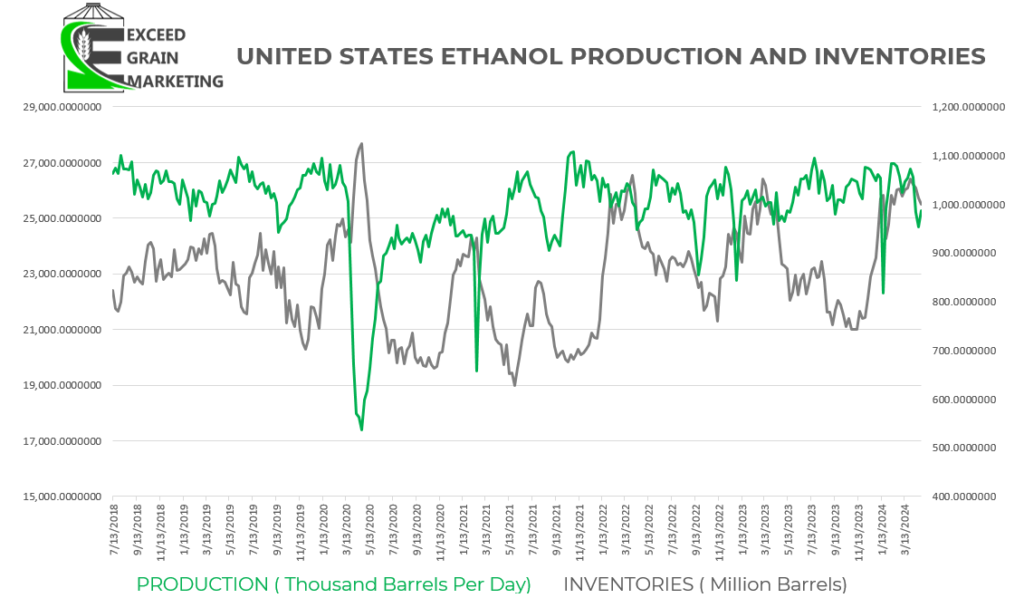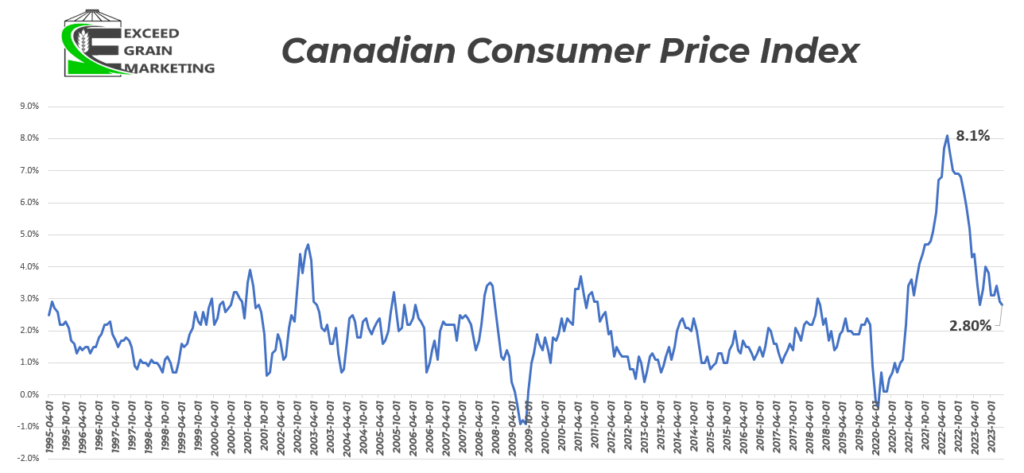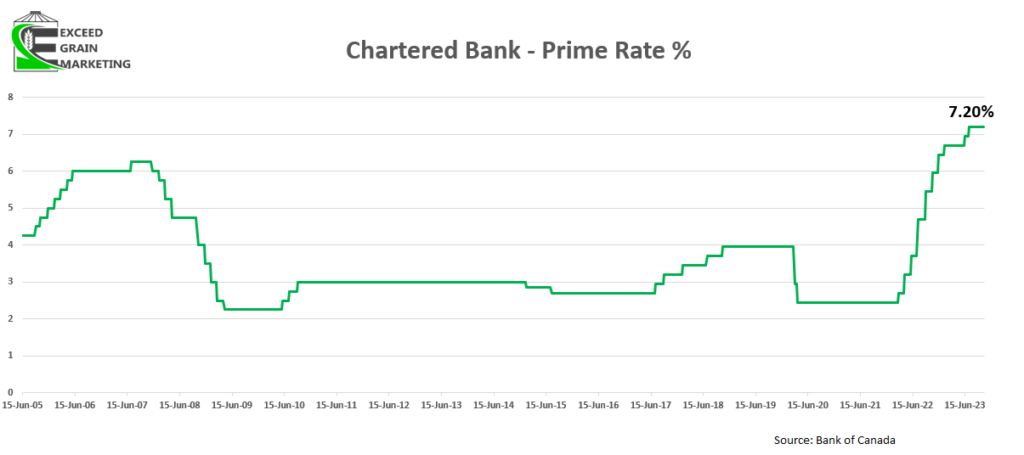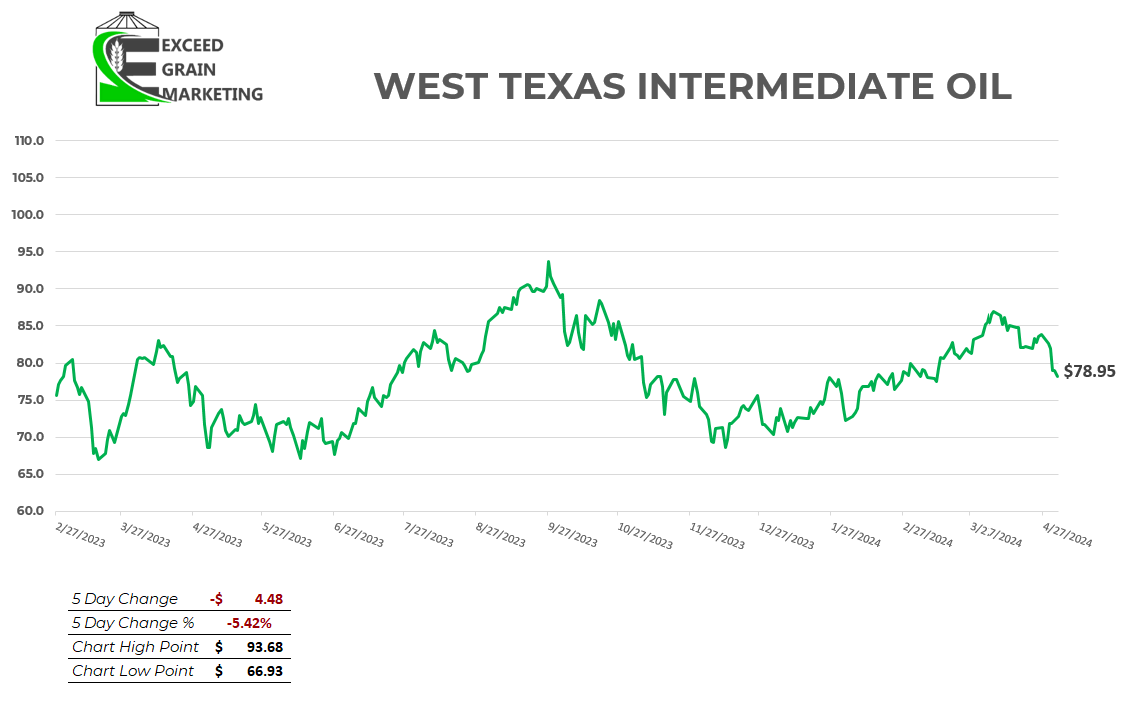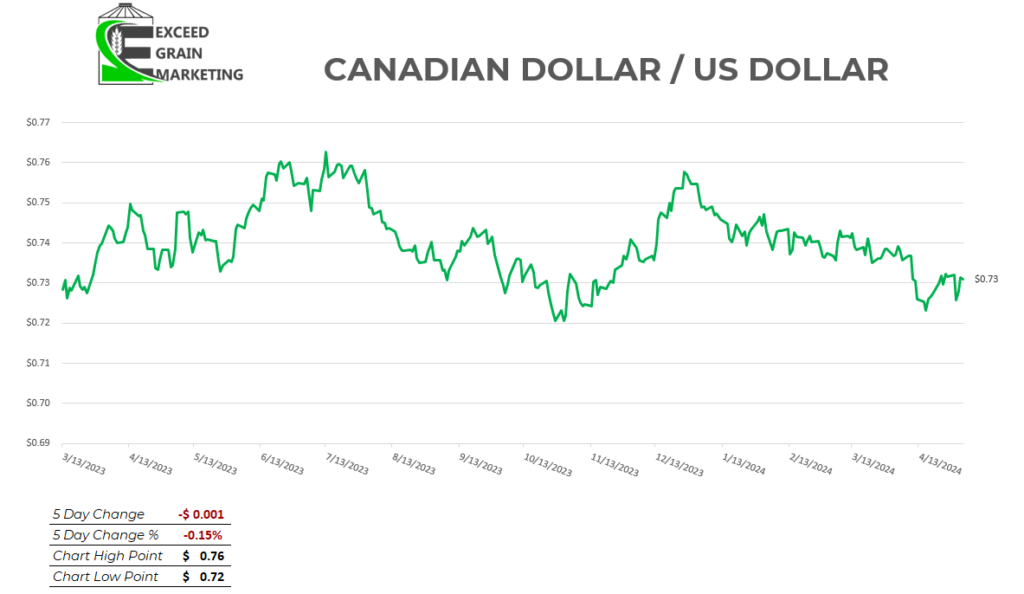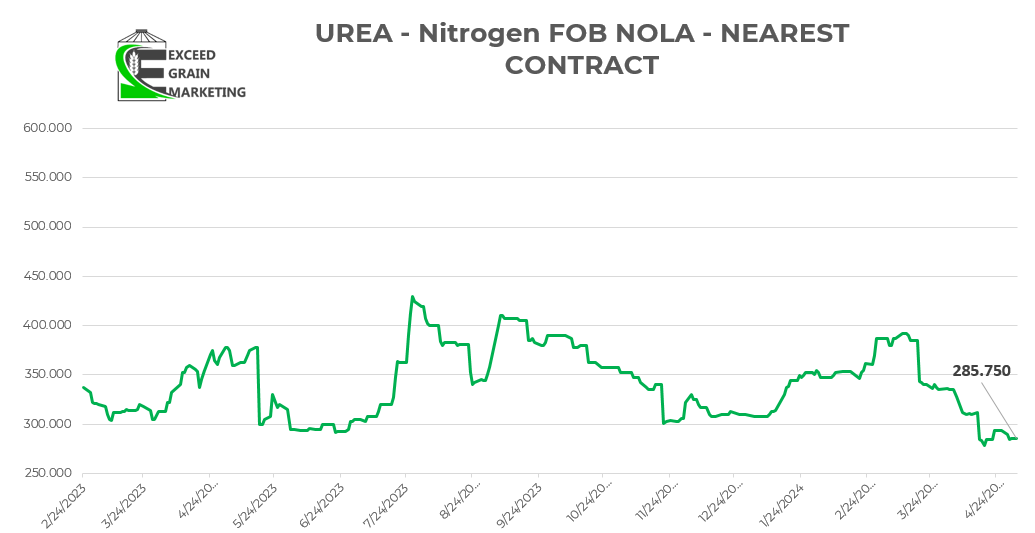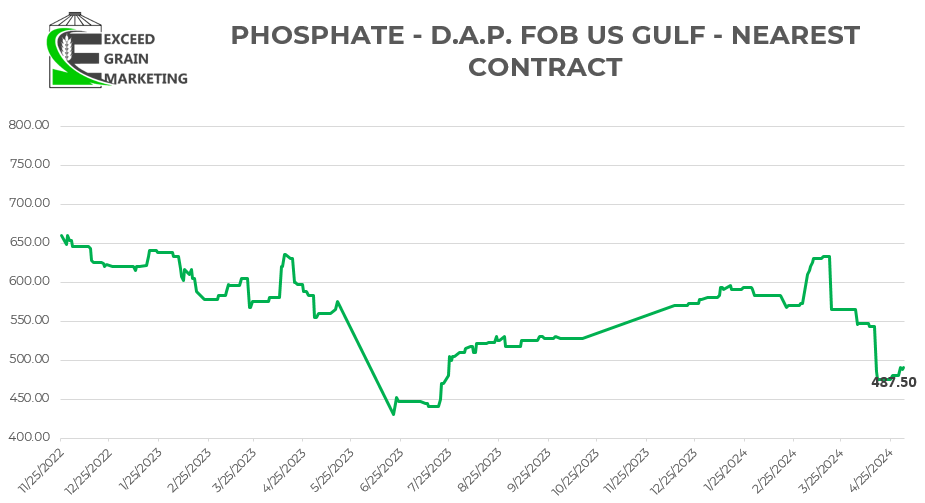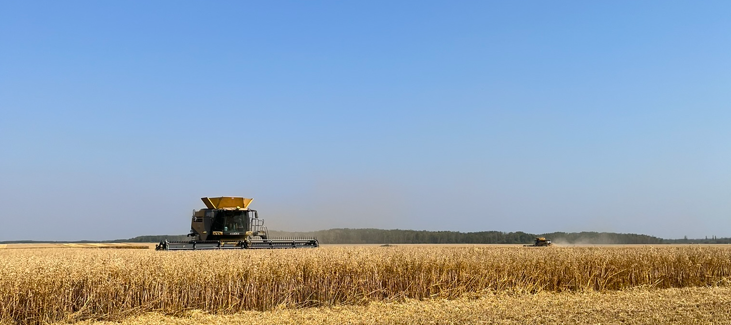Exceed Grain Marketing’s Client Exclusive report is dedicated to covering the ongoing trends and significant highlights within the local market, while simultaneously offering a perspective on the global landscape. This approach ensures a comprehensive understanding of the factors influencing the market at both local and international levels. Our aim is to deliver current, up-to-date information specifically tailored to the crops impacting your operation. Work with your Exceed Grain Marketing advisor to devise specific strategies that may work for your crop.
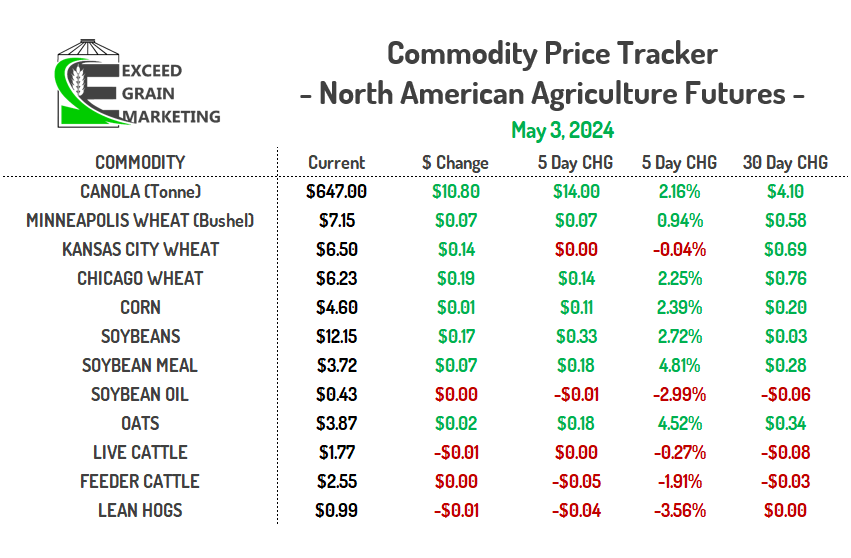
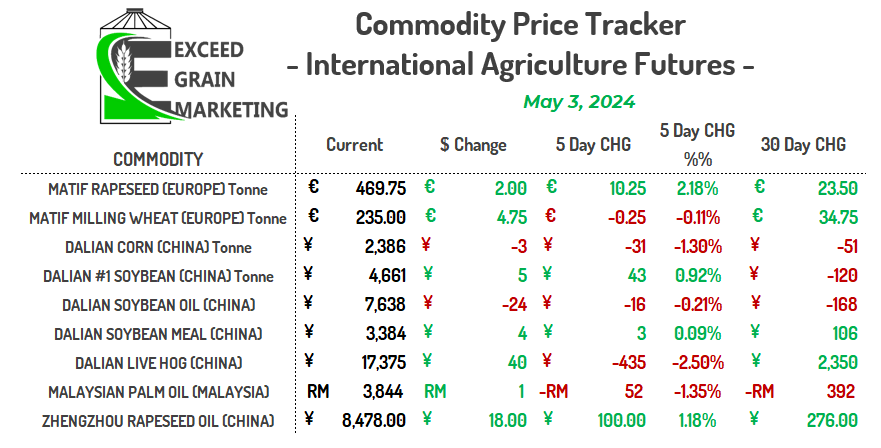
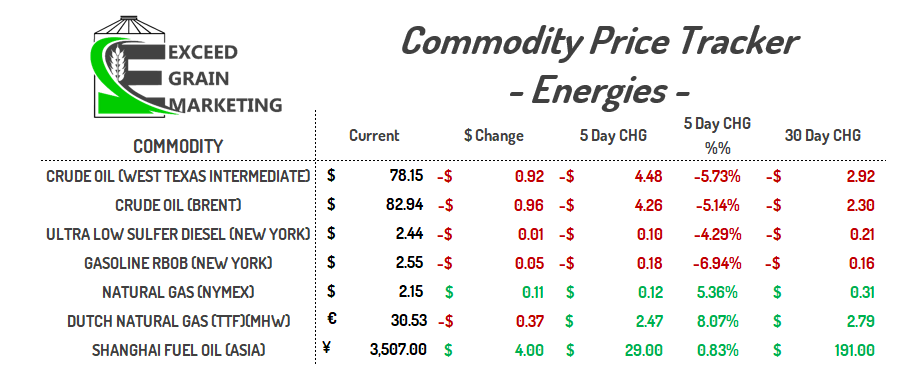
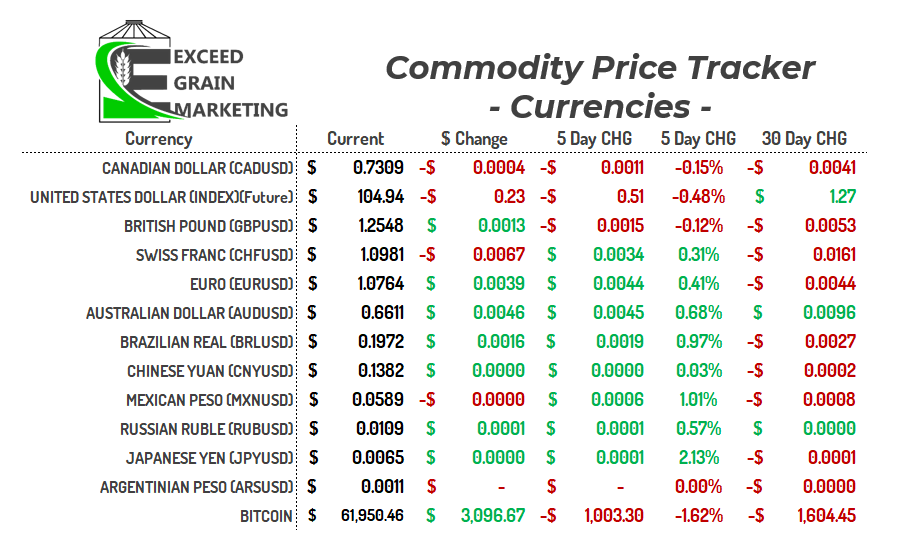
MARKET HIGHLIGHTS
- Corn, Soybeans, Wheat and Canola all close the trading day higher while Soybean oil lower. Relatively strong week in markets, especially for Soybean Meal. Most grains closed the week higher. Soybean oil traded the week lower.
- Overseas, Palm oil traded lower, while MATIF EU Rapeseed posted a healthy gain of 10 euro per mt for the week.
- CN and CPKC railway employees, Canada’s two major rail systems have voted to start striking as of May 22nd if their contract is not renewed to their standards. This would be very significant to export movement if not resolved before that time.
- North American producers will welcome India’s extension of the Yellow Pea tariff exemption. Yellow pea imports will remain exempt from import duties until October 31st, 2024. Moving the exemption into the new crop season.
- Desi chickpeas will now be exempt from tariffs until March 2025.
- Weather stories dominated the market news for the week. Massive flooding rains in southern Brazil state of RGDS upwards of 20inches of rain in the past month. Around 25% to 33% of the crop is yet to harvest there and the state is generally about a producer of around 20mmt of soybeans
- US Midwest getting soaked with several inches of rain and Soy and Corn areas now at risk of delayed planting. More will be know on Monday with the release of the weekly crop progress report. Markets pricing in some delays here although. Rains fell in some winter wheat areas this week, although not as widespread as the producers had hoped. Some significant dry pockets still exist there.
- Russia’s winter wheat production region being dry has also been a part reason behind wheats strength, now the drought region of southern Russia is forecasted for frosts this weekend. Private analysts looking to lower production estimates but are seeing how the next week or two pan out in the area. Crop is perceived to being getting smaller, not larger, in the region.
- Stronger week for domestic markets as many old crop and new crop wheat targets were achieved by producers across western Canada given some interest by Canadian exporters. Canadian wheat exports remain on a record pace and could push domestic stocks to multi decade lows.
- We will have a better understanding on domestic old crop stocks in Canada after next Tuesday. Stats Canada will be out with the end of March grain inventories for the nation on May 7th
- Markets expecting high barley ending stocks and low wheat stocks.
- Canola stocks expected to be higher than years prior, domestic usage was high for the 2023/24 crop but exports lagged early on in the marketing year.
- Frost in parts of Germany and Poland last weekend has caused some damage to the blooming crop, no one has put a quantity on the damage but the EU rapeseed was already smaller than last year prior to the frost, now the quality and quantity is at risk of dropping further. Many private agencies have the crop at 18ish MMT vs the 20MMT mark last year.
- The narrative has already begun that EU will need to import around 6mmt of Rapeseed/Canola for the upcoming campaign. This past year Canada missed out on most EU business in favor of Ukraine and Australian origin of cheaper origin. Market will be watching this closely as to how it will develop from here forwards.
- Canola and Soybean oil appears to have broke its close spread relationship about mid April. See chart below of “Global Veg Oils” but canola and soybean oil had been trading in lockstep with each other for most of winter. This should be noted and followed.
- Argentinian soybean harvest at around 35% completed. Coming in good and mostly as expected.
- May 10th, USDA WASDE RELEASE DATE.
- French wheat conditions sit at 63% good to excellent, unchanged from last week and down from 93% last year. France is the largest producer of wheat in the European Union, with about 25% of the 134,000 tonnes produced annually.
- Western Australia Dry. No major rain events in forecasts. Needs rain soon or could see risk to main production areas of Canola. Planting well underway in WA and about mid April we will have a better understanding as to how much canola acres areis going in the ground.
- Chinese end of March hog inventories at 408 million vs 431 a year ago.
- Watch for US crop progress report out on Monday afternoon.
- April CONAB report put Brazilian soybeans at 146.5 mmt corn at nearly 111 mmt, big divergence from the USDA’s figures as you can see in tables below, market not putting much weight into this spread although.
- USDA WASDE April 10th Highlights:
- Tables of the Trade Below
- Global Wheat ending stocks at 258.3MMT vs 258.8 last months and 259.1 pre report estimate
- Global Corn ending stocks at 318.3 mmt vs 319.6 mmt last month and 316.7 mmt pre report estimate
- Global Soybean ending stocks of 114.22 vs 114.27 last month and 113.7 pre report estimate.
- Soybean oil at 5.16 vs 5.01 last month
- Rapeseed/Canola ending stocks of 7.82 mmt vs 8.07 mmt month prior.
- Next month for the May WASDE we get new crop estimates.
- Strategie Grains, French Private Analysts place EU barley up 10% year over year. April estimated Rapeseed production at 18.1 mmt vs 18.3 month prior, 19.9 mmt was the production number last year.
- Pea export pace up 12% year over year, due mostly to reduction in Indian tariffs. New crop peas remain strong in Western Canada
- Advance Payment Program payments are now available to Canadian farmers for the 2024 program year. Starting April 1st the advance is available to producers. Often referred to as the CCGA cash advance. The program provides up to a $1 million cash advance with a $250,000 interest free bearing portion.
- European Union proposed new tariffs on Russian grain: 95 Euro per tonne for grains. 50% for other crops. Subject to approval by the 27 member organization. If you are a Flax producer, keep an eye on this.
- Recommendations Page Updated at Bottom of Report
Prior Report Section
- Statistics Canada Acreage Estimates Analysis (March 11th).
- Canola acres down year over year, Spring wheat and Barley were down as well.
- Chickpeas showing the largest percentage gain year over year and Flaxseed the largest drop.
- Oat acreage came in on the low side of pre report estimates despite a large year over year spike in acres. Oats still running some relatively low acreage numbers compared to years past. Take a look at chart below to see the past few years of acreage
- Canola came in near the bottom end of pre report estimates, but more in line with some longer term averages for acres.
- Stats Canada conducted the survey from December 14th – January 22nd and surveyed 9,600 farms. There have been significant changes in New Crop markets since this time and one can expect that final planted acreage will shake out a tad different than what was reported.
- Prospective Planting Acreage (March 28th, 2024)
-Corn 90.04 million acres vs 94.6 million last year and 91-92 million acres expected pre report
-Soybeans 86.5 million acres vs 83.6 million last year and 86.5 to 87.5 pre report
-Wheat 47.5 million acres vs 49.6 million last year and 47-47.3 pre report
Of the wheat acres 11.3 million are destined to be spring wheat vs 11.2 last year
Corn was the surprise in todays report with limited estimates reaching as low as a 90.04 million acre corn number.
Quarterly stocks report was also released today. Stocks came in fairly close to estimates with some divergence. Corn lower and beans and wheat stocks higher The most notable takeaway from the stocks report is the growth from last years stocks at the same time.
Quarterly Stocks Report:
-Corn 8.35 billion bushels vs 7.4 billion bushels
-Soybean 1.85 billion bushel vs 1.69 billion bushels
-Wheat 1.09 billion bushels vs 0.94 billion bushels


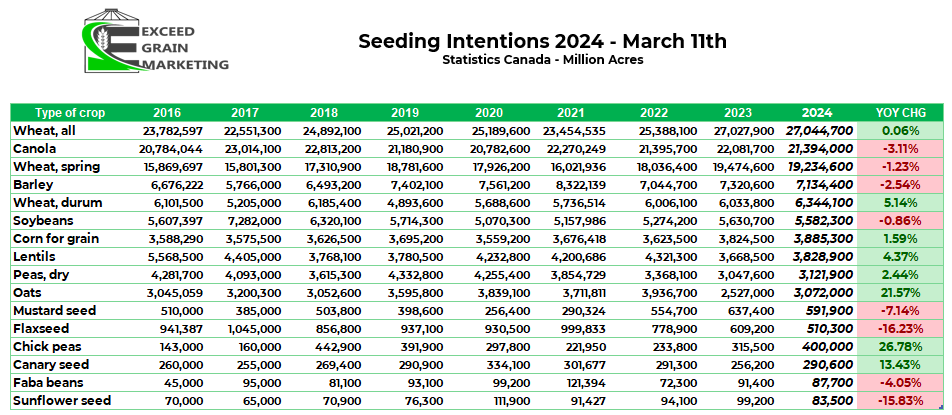
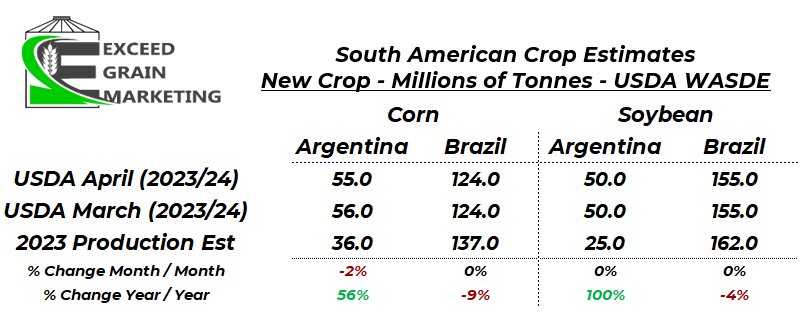
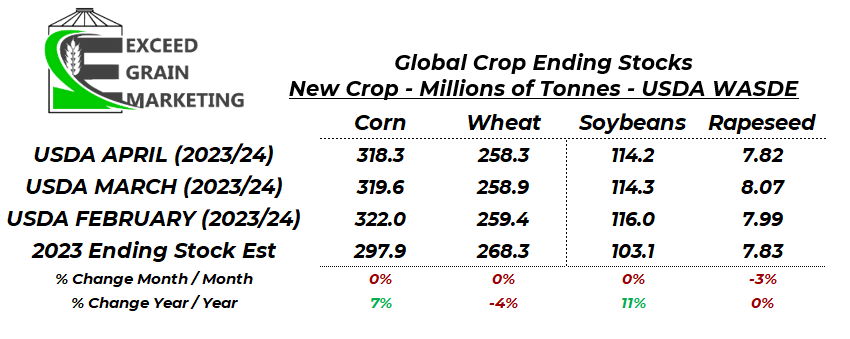
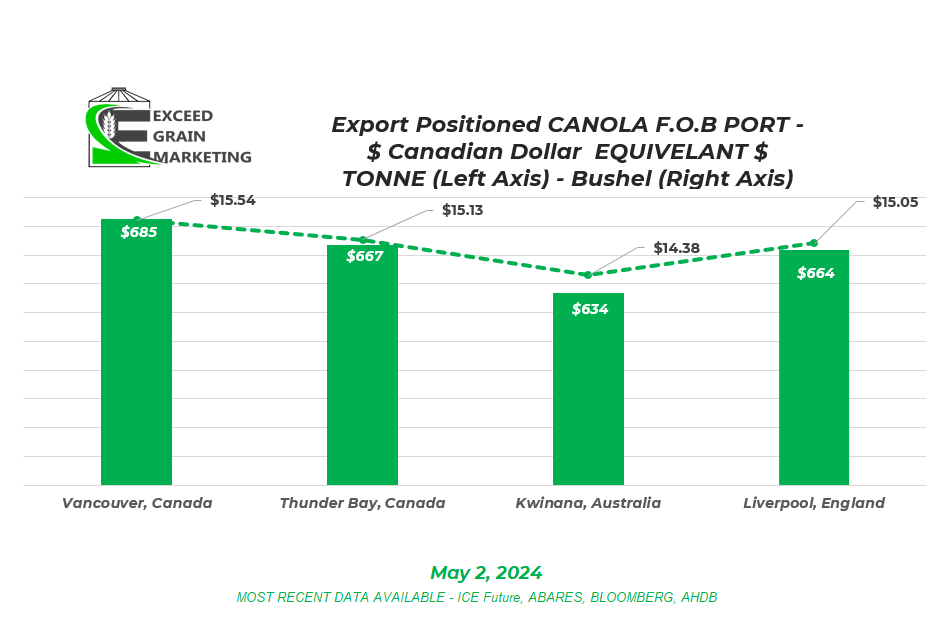
WESTERN CANADIAN CROP NOTES
Canola:
- Crush margins narrowing up. Vegoil values have took a hit and the oil share of the crush is worth less, significant for canola as that’s traditionally where most of the crush value sits.
- We hit some important sales targets for our grain marketing clients in past few weeks due to the recent run up in futures from the February lows. See recommendation section below. May Canola rolling off the board and July Canola is now the front month for marketing purposes.
- Be sure to be looking at important dates for rolling forward any basis if required. Mid June is often when many grain buyers need to know if rolling or pricing.
- Crushers filling up domestically for the front months as producer selling took up much of the front month capacity. Most crushers bidding June onwards. If need crusher movement, need to build a plan around that. July/August is where most capacity lies within the crush. Be cognizant of export and crush capacity as we get closer to the dates.
- Canola now once again pricing more expensive than Australian Canola after being cheaper than them in late February and into early March. The difference between exporter bids has narrowed up significantly in recent weeks. Canola carried such a premium to Australian canola and EU canola through the first half of the marketing year. It narrowed up significantly for several week but is showing signs of building that spread again. Chart above shows most recent bids at some key export regions in Canada, Germany, Australia and England.
- Canola exports bouncing around. 87,000 Week 39 180,000 Week 38. 128,000 tonnes in Week 37. Good week 36 with 162,000 tonnes leaving Canada, but Week 35 numbers were dismal with what looks to be one ship leaving shorelines, the week prior, almost 250,000 tonnes was moved.
- Current export pace of 6.2+ mmt is not great overall and would be one of the lowest levels of exports in decades. See chart below for reference
- We need to grab exports on the tail end of the marketing year to maintain a reasonable carryout in the market. We have 14 weeks of export left in this marketing year. Need consistent movement here on forwards
- Crush is running at a very impressive pace, looks like we will surpass and hit a 11mmt + record. Markets need to see exports pick up to get any sort of strength into the domestic trade (Basis).
- Canola will trade at the mercy of foreign veg oils for the time being (Palm, Soy, Rapa). It is unique to note that since about Mid April, Soybean oil and Canola oil seem to have broken up their closely held relationship.
- Crusher bids still dominate but are falling closer to exporter prices, depending on the month. Most exporters sit close to the $14.00+ mark today, depending on region and Basis levels. Crushers still hold the leading bids, but the regions are getting fewer and further between and months are getting tighter. Crushers hold the winning bid for new crop 2024 harvest
- For a more in depth analysis on Canola Specifically, check out our April 2024 Canola Fundamental report by clicking here: Canadian Canola Market Fundamentals – April 2024
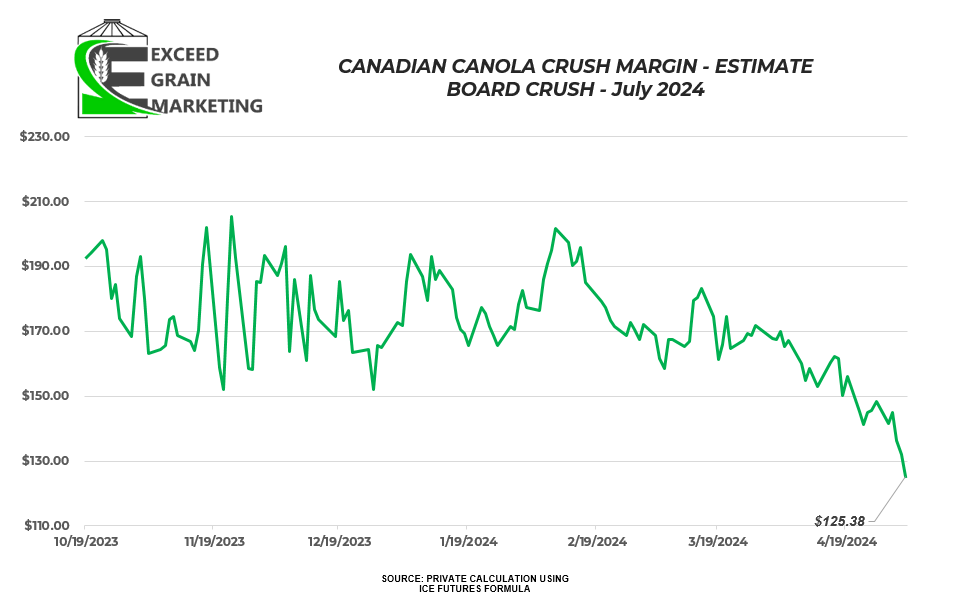
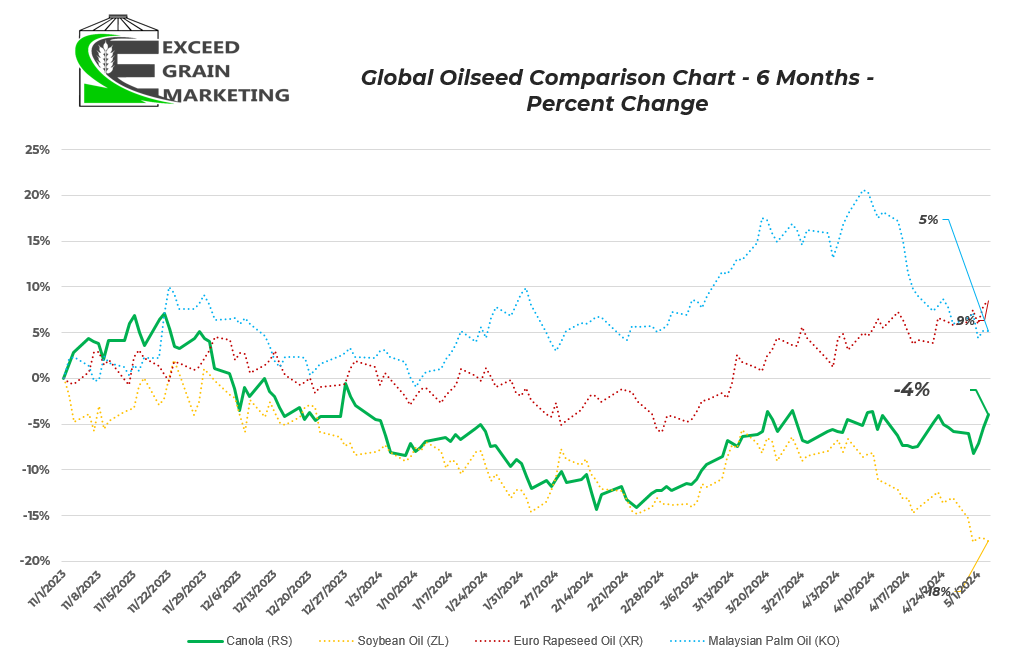
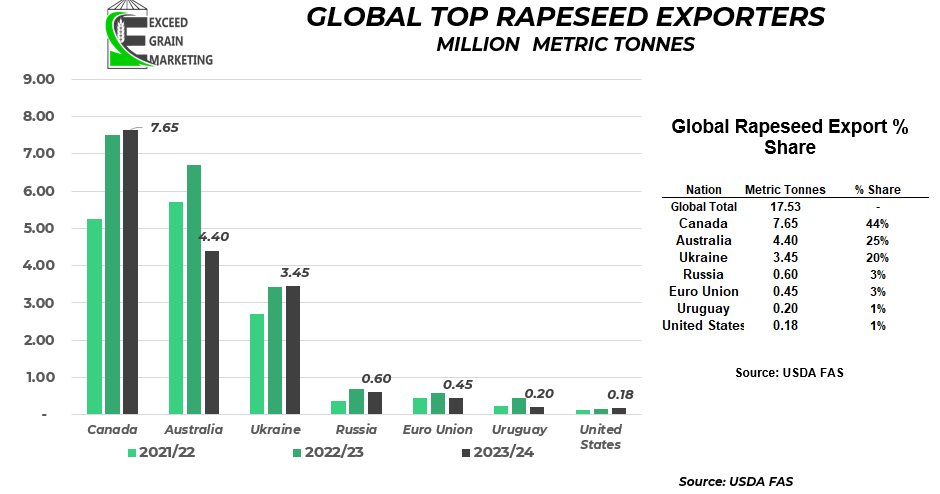
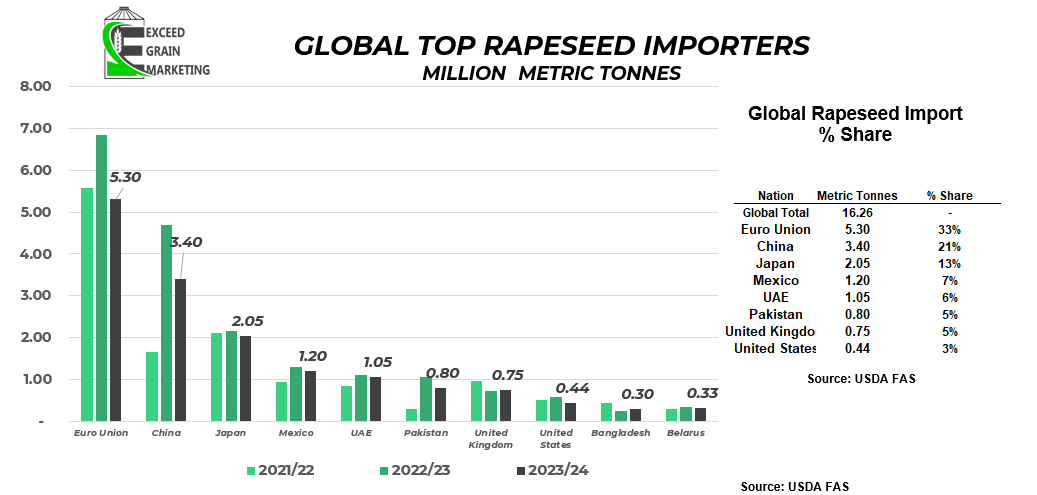
Spring Wheat:
- Russia very dry in its main wheat production regions, could see frost early May according to forecasts. Indian stockpiles of wheat lowest in 16 years. Very dry winter wheat production area in United States, although some rains have alleviated the margins. US winter wheat region to get some rains over the weekend again, trade will be watching closely to see what fell over the weekend come Sunday/Mondays open.
- Russian wheat bids up around $20 per tonne in recent weeks. Was as low as $200 per tonne and now trading closer to the $220 level.
- Russia has been playing games with exporters here since start of April, revoking some export licenses of key exporters and then reinstating them within a few days. Analysts believe the government mostly using this as a way to control exporters and let them know that they still rule the roost if unwilling to comply with government requests.
- Anecdotal reports of Russian farmer selling slowing down due here recently. New crop will be off beginning in July and the anecdotal sentiment is towards producers willing to sit on inventories for the time being.
- Domestic wheat bids in Western Canada touching that $9.00 to $9.50 range for old crop. $8.25 up to $8.75 for new crop. New crop bid spreads very wide and wide spreads across the prairies.
- Looks like Black Sea regions willing to dump grain here before summer. New crop will be in the system starting July 2024 so exporters looking to keep product moving.
- Canadian Wheat exports and domestic usage is still considered very strong. At the current pace of exports and domestic usage, rationing will be needed. This does not always mean price correlates accordingly, as we have seen in recent weeks. Prices have seen producers selling into them.
- Wheat exports expected to easily surpass last years levels at current pace and are on track for an 8% increase year over year. Likely not able to make that happen although as rationing will supersede this.
- 2023 Old Crop Canadian wheat of good quality. 97% graded as either a #1 or #2 HRSW
- 80% had falling number above 350 seconds
- Wheat trade right now is mostly demand based. We have a good idea on global supplies for the most part.
- Forecasted wheat global and domestic ending stocks coming in at the tightest levels since the 2015/16 crop year.
- Next thing market will be watching for is crop progress in the US and EU winter wheat crops and Spring Wheat planting conditions.
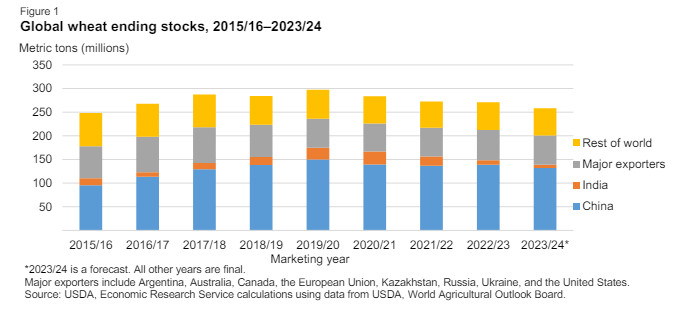
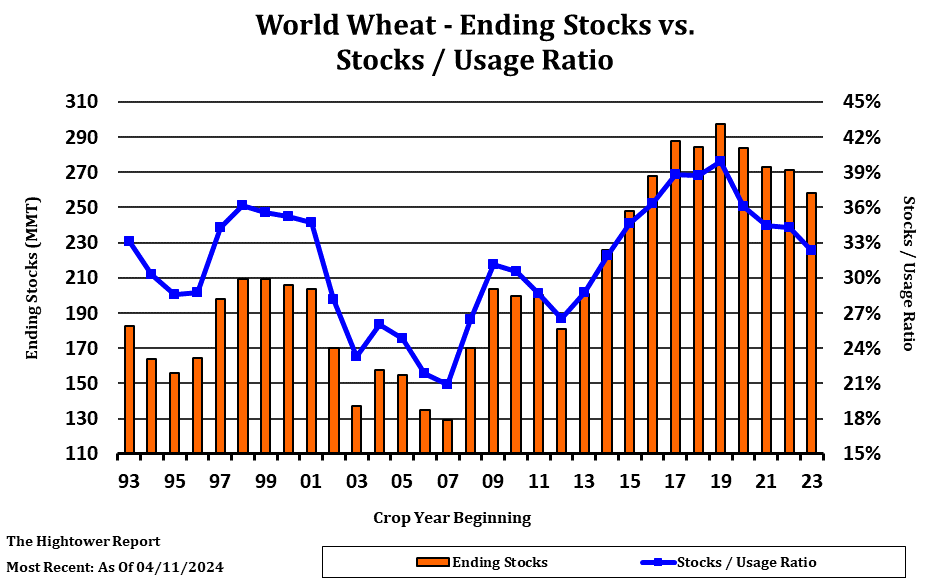
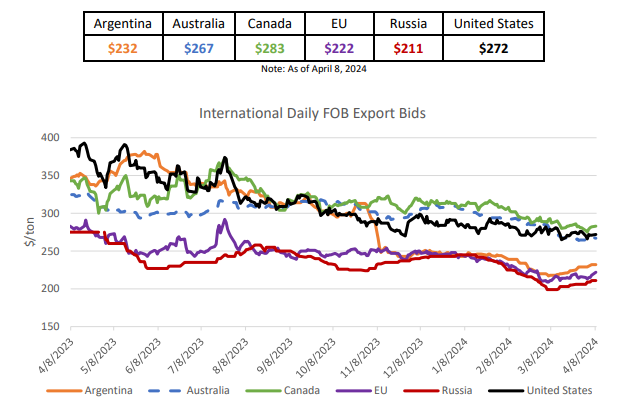
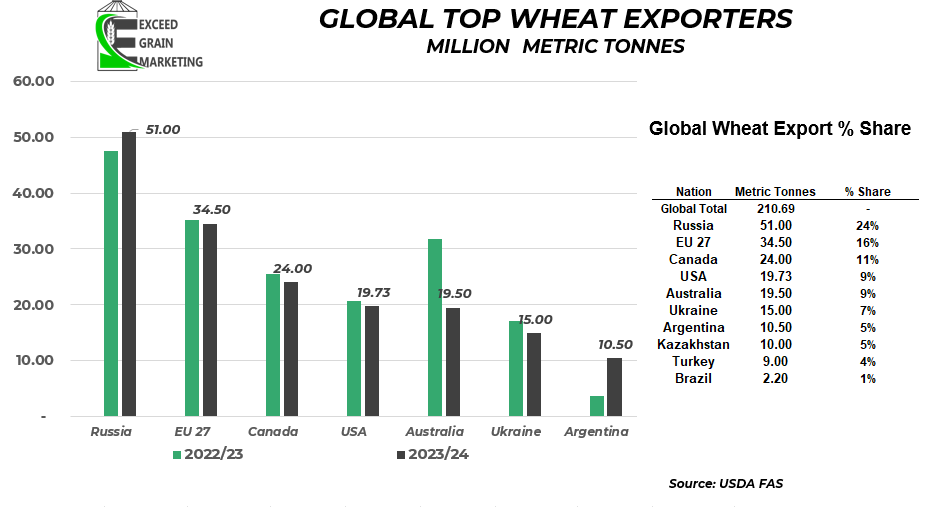
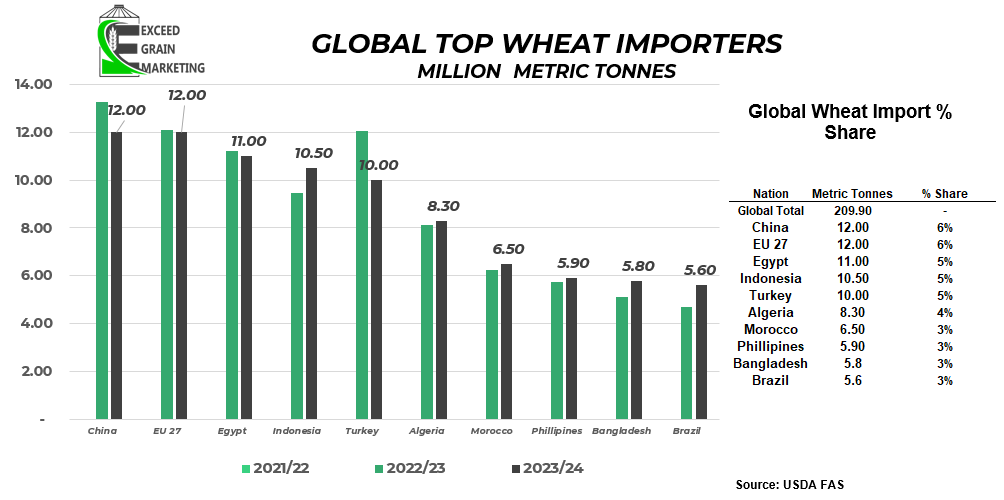
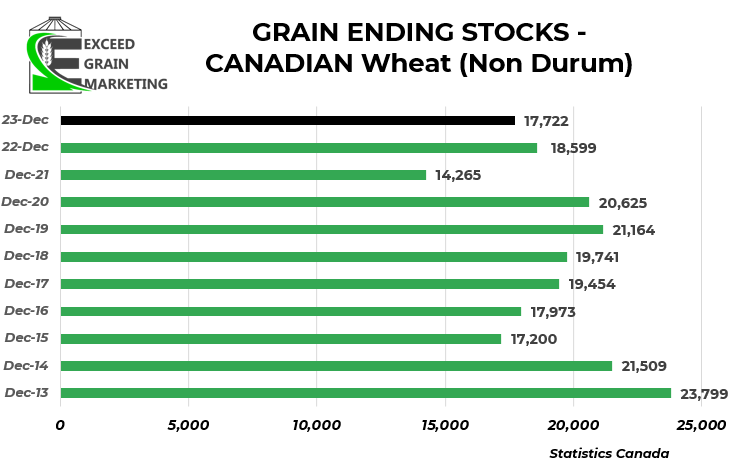
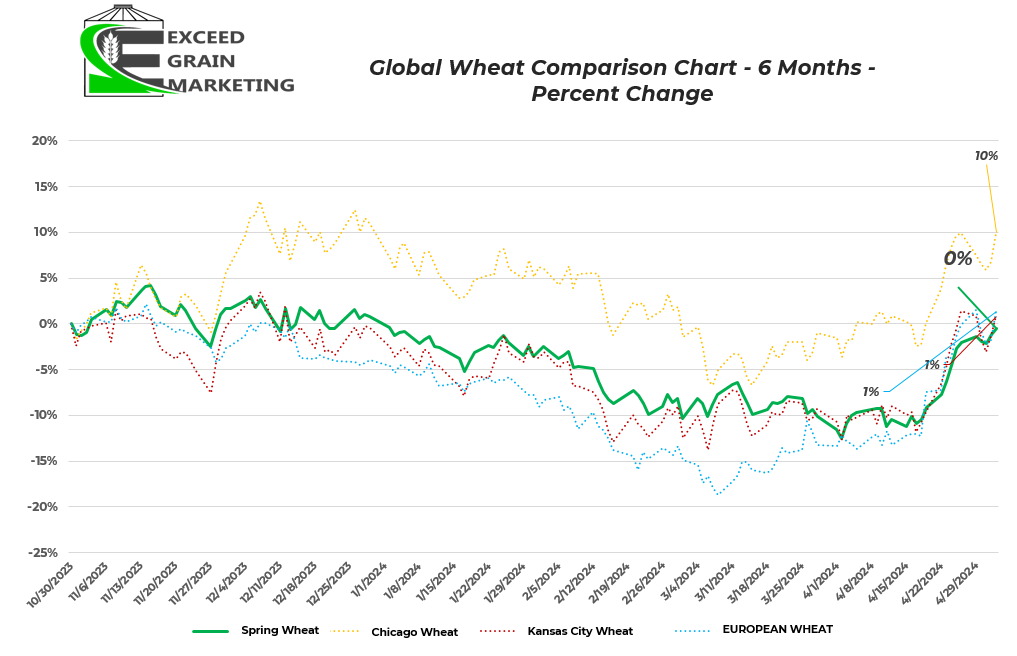
Special Crops
- Turkey tendered for durum this week. Looks like Viterra grabbed some of the business $328 USD per tonne.
- Minimal stocks of Canary Seed in Thunder Bay has markets reduced hopes for a spring export sale
- Yellow Pea and Lentil Acreage expected to grow in Canada for the marketing year. The pulse crops are showing some excellent return potential for the 2024 cropping season if producers can bring it to yield at harvest.
- Special crop markets closely watched Marchs release on acreage estimates from Stats Canada.
- Barley acreage drops to 7.1 million acres. Fits in line with some trendline averages
- Barley prices lower than last year, as with many crops. Some $5.00+ feed opportunities available central Sask. Greater as you move closer to Feed centers. Add $1.25 to $1.50 for Malting.
- Durum acres up 5% year over year. One of the largest acreage estimates in recent years
- Lentil and Pea acres up year over year but still not out of line with recent history.
- One thing to note from this report is that it was collected from December to January 15th. Lots has changed in this timeframe.
- Canadian peas will face stiffer competition going forwards into China as some Black Sea peas able to price into the region.
- Canadian red lentils also competing with a larger Australian crop. Indian lentil harvest taking place here in the coming weeks and crop is expected to be of a healthy size. Looks like higher availability for global export market
- India reduced Yellow Pea import tariffs from 50% down to 0% was extended for several months and now sits at October 31st, 2024. Was only in place until end of March but another month, and then another, was added to get exports into the nation.
- Durum exports lagging behind last years pace. Durum exports have somewhat disappointed traders as we missed some key export opportunities early on due to some better than expected Mediterranean/Turkish crops. New crop Durum bids have fell from earlier on. $10.00 was attainable but now sits closer to $9.00. Local variances.
- Durum growing regions of Canada have got some recent precipitation but will be dependent upon some key rains following planting, producers somewhat hesitant to price aggressively on new crop.
- Red Lentil reduced import tariffs extended until March of 2025
Latest Key Fundamental Report Highlights
- STATS CANADA ( DECEMBER)
- March 11th we got Principal Field Cropping Areas – See above
- December 5th production estimates. Stats Canada report came in and was mostly as expected but higher than the prior report released pre harvest.
- Canola- 18.3 mmt vs 18.3 mmt pre report estimate
- Spring Wheat – 24.7 mmt vs 24.0 mmt pre report estimate
- Barley 8.9 mmt vs 8.6 mmt pre report
- Oats 2.6 mmt vs 2.6 mmt pre report
- Durum 4.0 mmt vs 4.1 mmt pre report
- Corn 15.1 mmt vs 15.0 mmt pre report
- Soybeans 6.98 mmt
- Lentils 1.7 mmt vs 1.7 mmt pre report
- Peas 2.6 mmt vs 2.6 pre report
- Flax 0.272 vs 0.290 pre report
- Most of the production numbers are higher than they were in the early days of harvest when ideas for the canola crop were floating around a high 17’s number. Same could be said for Durum and a few other select crops.

Currency – Energies – Fertilizer
- Bank of Canada Stays Put with current interest rates at the latest interest rate meeting. Prime sits around 7.2% at major Canadian banks. Hinted that we could be higher for longer. Cuts will not be significant if they do come. The Bank of Canada has also recently hinted that one could face another rate hike but it is hesitant to do so given that Canadians are feeling the pinch of higher rates.
- Canadian CPI Still “Sticky” and sits at 2.9% as of the latest announcement in February.
